Are you looking for Madrid experiences that will stick in your memory? There are so many interesting things to do in Madrid that it’s hard to determine what should make your itinerary. Well, we think we have come up with a great list for you to work through for your planning.
What you will find here
How to find interesting things to do in Madrid
We loved our time in the Spanish capital but with only five days to explore we did not get our through our wishlist, and we can hardly declare expert status 😉 so we asked our fellow Madrid loving bloggers for help.
Today they share their thoughts on the best-known things to do in Madrid with a sprinkle of more obscure choices to keep things interesting for first-time visitors.
This post may contain affiliate links. If you book via these links, we may make a small commission at no extra cost to you.
Dine at Chocolatería San Gines
Tom Bartel from Travel Past 50 lets us in on Madrid’s best-known hot chocolate. Charles loved these too, but they were not really my thing. I am neither a doughnut or a chocolate lover.
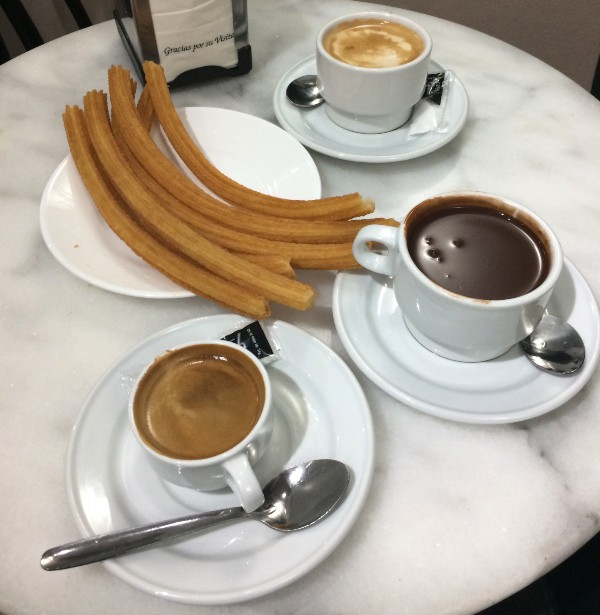
For your morning coffee or chocolate in Madrid, you can’t do better than Chocolatería San Gines. It’s just off Calle Arenal about halfway between the Puerta del Sol and the Plaza de Ópera.
You’ll probably stand in line for a few minutes to order at the cashier just inside the door. You get your ticket, and then wait a few minutes for a table to open up. When you get a seat, you give your ticket to a waiter, and a short time later, deliciousness appears on your table.
There are four combinations of standard fare. To drink, you can either have coffee with milk (café con leche) or hot chocolate. Then choose either churros or porras, which are basically just bigger churros.
In case you don’t know, churros and porras are the Spanish equivalents of doughnuts. They are dough deep-fried to airy tubes–and are usually sprinkled with powdered sugar–although they are so delicious, you can certainly forego the sweet garnish.
The essence of the Spanish churro breakfast is not the churros; however, it’s the chocolate. Warning: This isn’t the thin beverage that Americans call cocoa or hot chocolate. This is thick, dark, bitter chocolate that comes in a cup, and is too thick to drink. It exists solely for dipping your churros and then using your spoon to get the last bit out of the bottom of the cup.
Where: Pasadizo de San Ginés, 5, 28013 Madrid, Spain
Related: Check out our itinerary for 3 days in Madrid
Drink in the view at Cibeles Rooftop
Inma Gregorio from A world to Travel shares one of the best viewpoints in Madrid. We visited in the day time and agree the view is fantastic.
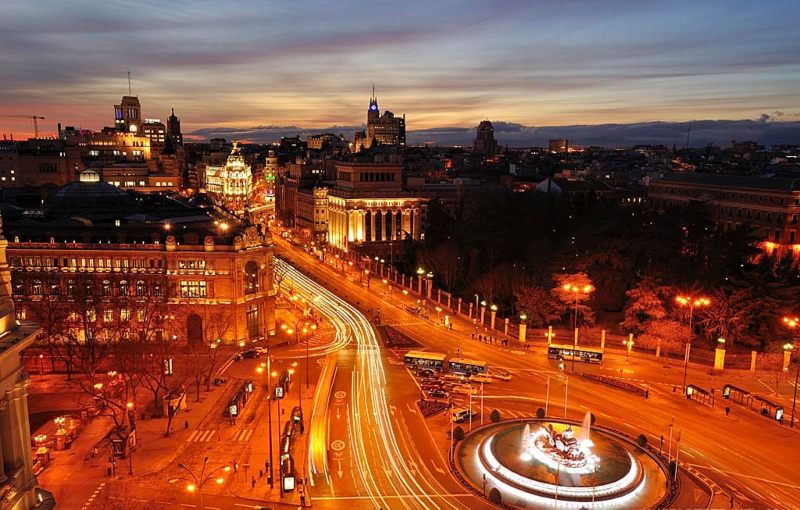
Every time I have the chance to spend a night or more in a new city, one of my biggest hobbies is to climb on a terrace to admire the sunset views.
In Madrid the options are many, one of the best is the Cibeles terrace. It is very busy due to its central location and incredible views. From here you can see the famous Cibeles square and the surrounding streets such as the one that goes towards Paseo de la Castellana on the right side and the one that goes up Alcalá street towards Madrid’s melting pot, Gran Vía, right in front.
This terrace lends more to a coffee or a drink than to snack. On the other hand, its menu is quite expensive by the standards of this country. As a reference, an alcohol-free drink is around €6. In any case, it is possible – if you are lucky and the terrace is open – to simply go up for a while to enjoy the view before continuing your walk through the capital of Spain. Although sometimes, you can find a sign at the entrance of the terrace that specifies that a minimum consumption of €6 is required.
The nearby Circulo de Bellas Artes and City Hall rooftop terraces are also an excellent option to catch a great Madrid sunset.
Where: Plaza Cibeles, 1, 28014 Madrid, Spain
Visit Cervantes Birthplace Museum
Gwen from Healthy Travel Mom suggests a visit to the museum dedicated to one of Madrid’s most famous authors. We stayed in an apartment in Calle de Cervantes in Barrio de Las Letras and were surrounded by his words on plaques in the footpath. I only wish I had known about this museum.
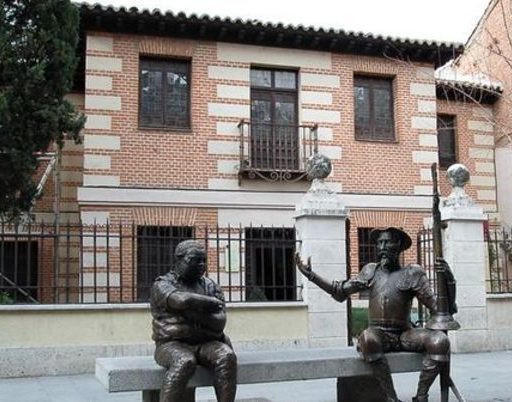
Alcala de Henares – more commonly referred to simply as Alcala – is a picturesque town located approximately 22 miles east of Madrid and an easy day trip by train. One of the most popular places to visit in Alcala is the Museo Casa Natal de Cervantes (Cervantes Birthplace Museum), where Miguel de Cervantes was born and spent his early years.
Cervantes is considered one of the greatest literary minds in the Spanish language. He was born on September 29, 1547. His most famous work is “Don Quixote.”
The historic two-story house has been restored several times over the centuries. Today it is designed to look much like it did when the Cervantes family lived there in the 16th century. It is a beautiful building with Renaissance-era architecture and an open courtyard in the centre.
Step into the museum, and you will be transported back in time. The museum’s rooms are spread over two floors encircling the interior courtyard. You’ll learn about the iconic author and his life as you meander from room to room. The different rooms recreate the customs and daily activities of the 16th century – including a ladies’ drawing room, dining room and nursery. The museum also has an impressive collection of Cervantes’ works.
In addition to its truly one of a kind exhibits, the museum regularly hosts cultural events for visitors of all ages. If you are planning a visit to Madrid, be sure to add Alcala and the Cervantes Birthplace Museum to your itinerary.
Where: Calle Mayor, 48, 28801 Alcalá de Henares, Madrid, Spain
People watch in Barrio de Lavapiés
Maggie Turansky who writes at The World Was Here First has suggested a visit to one of the cities most interesting areas.

While most visitors to Madrid will know to head to the Palacio Real, sample tapas at the Mercado de San Miguel, and enjoy the art in museums like the Prado or Reina Sofia, very few tourists tend to head to the south-of-central Madrid neighbourhood, Lavapiés.
The Lavapiés neighbourhood may well be the coolest barrio in Madrid, home to a multicultural population, hundreds of cool tapas bars and restaurants, authentic local markets, and a great street art scene. As more than 22% of Lavapiés residents are of non-Spanish origin, the neighbourhood’s diversity has led to it being one of the most dynamic and multifaceted barrios in the entirety of Madrid.
While there aren’t a lot of tourist sites in Lavapiés, it is a fantastic place to spend at least part of your Madrid itinerary especially if you want to get away from the major attractions and glimpse a true piece of madrileño life. Make sure to head to the Mercado Antón Martín where you can buy both local Spanish produce and indulge in some international food.
If you’re visiting on a Sunday, then the El Rastro flea market is a great place to browse for a good deal, rifle through antique stalls, and people watch. If you’re interested in street art, make sure to walk up Calle de Embajadores to see some of the most significant murals and art pieces in the city. There are also numerous tapas bars serving both traditional and modern cuisine from all over Spain, and it is a fantastic neighbourhood to explore if you’re looking for a unique night out.
All in all, no trip to Madrid is complete without a visit to multicultural Lavapiés, arguably the coolest neighbourhood in the Spanish capital.
Related: Are you visiting Barcelona? Check out our guide
Discover Malasana
Daniel James from Layerculture shares an area in Madrid that we loved and think you should take the time to explore. We particularly enjoyed the local bars here.

While looking for interesting things to do in Madrid, head over to the Malasaña neighbourhood. Known by many as the city’s bohemian district. You could say that this is one of the liveliest zones and very popular with the younger crowds. The good news is that the Malasaña neighbourhood has something for everybody.
One word to describe the area is authentic. You can find many unpolished streets, and even though the area has become a little more gentrified over the years, it’s still filled with a good selection of underground clubs and bars.
Maybe you’ll need to brush up on your conversational Spanish before you go? The area is home to some tasty fusion restaurants that you’ll find are mainly frequented by locals. There’s also a good selection of coffee shops and if you are visiting during the day, a handful of traditional tapas restaurants for when you get peckish during the early evening.
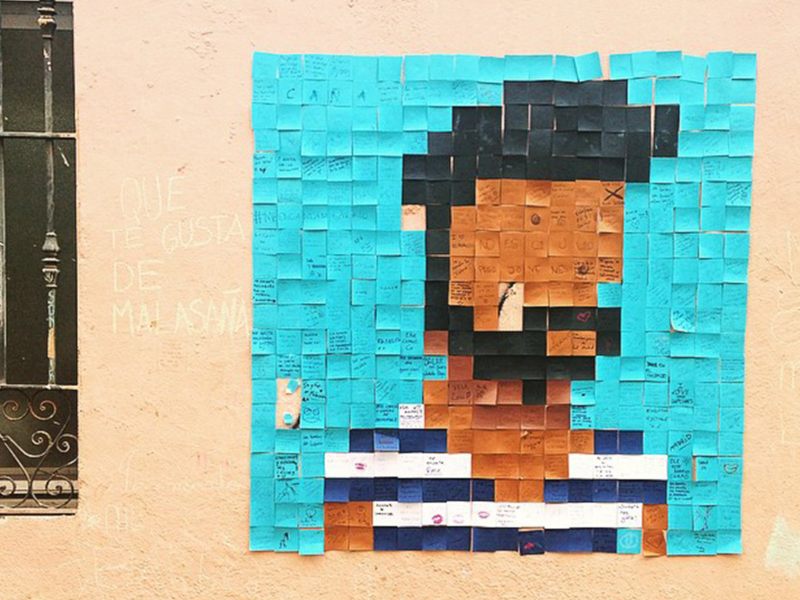
The zone itself is full of character, and not for the faint-hearted, so be prepared to enjoy a mix of street art, graffiti and if arriving in the evening, loud music and an endless swarm of partygoers. All in all, no matter what time of day you go, expect sheer entertainment as you walk around the streets of Malasaña.
Where: The main square is at Plaza del 2 de Mayo
Shop at Mercado de Motores
Helen Rapp from Helen on her Holidays, shares her visit to a popular monthly flea market held in a railway museum.

The Mercado de Motores is Madrid’s take on a flea market, but it’s much more than you might expect. Taking place once a month (apart from in Madrid’s sweltering summer months), the Mercado de Motores is an unmissable mixture of vintage emporium and makers market, with food trucks, music and films to keep you fed and entertained. If that wasn’t enough, it all takes place in Madrid’s Railway Museum in an old railway station, so you’re surrounded by old steam trains.
The Mercado de Motores is a brilliant way to spend an afternoon on a short break to Madrid. I visited on a weekend trip in October and really enjoyed browsing the craft stalls, and vintage furniture stands set up along the old station platforms, before sitting down with a coffee and a brownie and watching an amazing jazz band.
We had a look at the museum exhibits then got a snack of some Mallorcan style potatoes and sat down in the outside cinema to watch Grease in Spanish with a beer and free popcorn. If you’re visiting Madrid and your dates coincide with the Mercado de Motores, I’d recommend going along.
Getting there is really easy as well – it’s just a short walk from the Delicias Metro station. Check the dates of the next market here
Where: Railway Museum, Paseo de las Delicias, 61, 28045 Madrid, Spain
Check out more of Helen’s travels on her Instagram feed.
Visit the National Archaeological Museum
Sinjana from Backpacknxplore is a history lover and shares one of the less-known museums in the capital.

I think the National Archeological Museum is one of the most underrated destinations in the Spanish capital. We didn’t have it on our planned Madrid itinerary, but I am glad that we went there on our 3-day trip. It has an entry fee of only 3 Euros, which is valid throughout the day for multiple entries. The National Archeological Museum is a massive four-storied building, with each floor dedicated to one era of history – Pre-historic, Ancient, Medieval and Modern History.
It showcases the important part played by Spain in the development of human civilization. You can find the original fossils and remains excavated from sites of Spain and North Africa in the museum’s exhibits. I enjoyed the pre-historic and ancient zone the most and spent more there than any other. Every floor has multiple audio-visual pods that explain the history behind each of the exhibits. It is a great place to visit with kids as it will trigger their curiosity and answer a lot of questions.
The museum is situated at a walkable distance from the Retiro park and the iconic Alcala Gate of Madrid. The three famous art museums in Madrid are located within a walking radius of 4km. There is an android app which you can download on the phone to know more about the exhibits in the museum.
Where: Calle de Serrano, 13, 28001 Madrid, Spain
Related: How to Spend 3 Days in Seville
Wander Plaza Mayor
Chrysoula Manika writes about all things food and culture and today is sharing one of Madrid’s most famous squares.

Madrid’s Plaza Mayor (or Main Square) is a large square in the centre of the city which stretches 129 metres long and 94 metres wide. As is typical with Spanish squares, there are 10 archways around the square which work as entrances, as well as 237 balconies dotted around the square which offer excellent views.
The Plaza Mayor is one of the most picturesque sights in the city thanks to its impressive buildings that grace each side of the square. It boasts a wealth of history, culture and architecture, not least because it was the main square of Old Madrid during the 15th/16th centuries.
There is always something going on in this buzzing square to keep you entertained, and when not enjoying an event or experience you can simply watch the world go by from one of the many alfresco cafes and restaurants. While some of the restaurants here have higher tourist prices, it is still a fun place to enjoy at least one meal or drink during your time in Madrid.
The main sights to spot within the square itself include the statue of Felipe III in the middle of the square and the frescoed facade of Casa de la Panadería. The square is also home to regular Sunday markets as well as Madrid’s famous Christmas market which is a real sight to behold!
Where: 28012 Madrid, Spain
Read more of Chrysoula’s work on Historic European Castles
Explore the Reina Sofia
Abigail from Inside the Travel Lab tells us how to find one of the most famous Spanish artworks. Charles is a big Picasso fan and seeing this made him very happy 🙂

The Reina Sofia is one of the three places that make up the golden art triangle in Madrid. But it is perhaps best known for housing one of Spain’s most famous paintings: Guernica by Pablo Picasso.
Not only is Guernica a striking piece of work in its own right, a twisting mass of limbs and terror, bulls and blood, but the history of its creation and the story behind what happened after that illuminates as much as the artwork itself.
The title, Guernica, refers to the small village in the Basque area of Spain hit by Nazi bombs sent to assist General Franco during the Spanish Civil War. Historians argue that the event was the first known targeting of civilians by military planes.
Picasso decreed that the work should not return to Spain until democracy had been restored. The painting was completed in 1937, Picasso died in 1973, Franco in 1975 and Guernica reached Madrid in 1981.
The surrounding exhibition explores Picasso’s creative process. But there is more to the Reina Sofia than just Guernica.
The entire museum, officially the Museo Nacional Centro de Arte Reina Sofia, is dedicated to 20th-century art. While Picasso and Salvador Dali are the most famous artists, you’ll also find works by Joan Miro and many other Spanish artists as well as some international contributions.
The museum is located near the Atocha train and metro stations. Admission is currently 10 Euro, although look out for late evening openings and other special events when admission is free. Leave at least half a day to explore fully. During Summer or holiday periods it’s advisable to get your tickets in advance to save time
Where: Calle de Santa Isabel, 52, 28012 Madrid, Spain
Follow Abigail on Instagram for more great finds.
Tour the Palacio Real (Royal Palace)
Jo Karnaghan from Frugal First Class Travel is our go-to for planning trips to France; however today she is sharing her love of the Royal Palace. Sadly we only managed to view it from the outside. If only I had known how stunning the interior was.
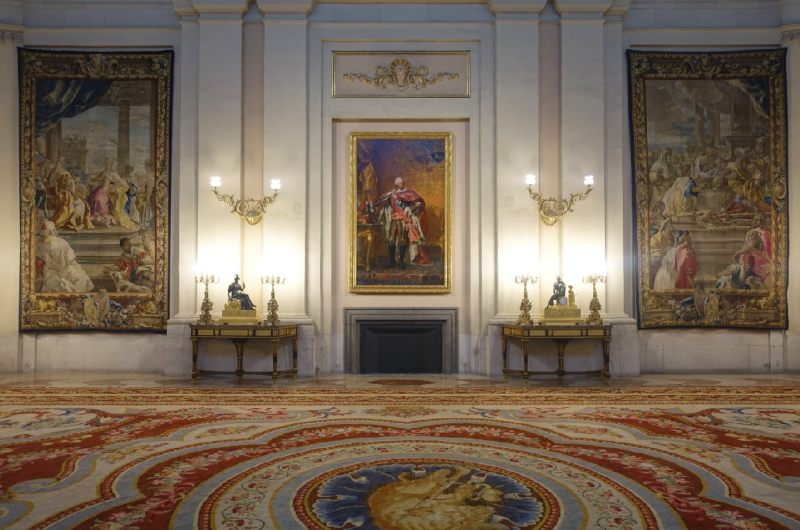
The Palacio Real (Royal Palace) of Spain is the third largest palace in Europe after Versailles and Schönbrunn. Fortunately, it is far less crowded than both. The current palace was built in the eighteenth century by King Philip V who wanted to create his own version of Versailles (having been born and raised at Versailles) – if you are familiar with Versailles you will see the references when you visit. The Royal Palace is located adjacent to the pretty Plaza de Oriente.
It is worth booking your tickets in advance because while queues are not as extensive as some tourist attractions, there is little shade, and it can be hot in the summer. With our time entry tickets purchased online, we were able to enter immediately.
As you would expect of an eighteenth-century royal palace, the Spanish Royal Palace is a riot of Baroque exuberance. While the grand staircase is impressive, it is the rooms beyond (where unfortunately photography is not permitted) that most truly reflect Baroque influences. The Gasparini Room is certainly not to everyone’s taste, but its cohesive design is admirable for its attention to detail and singular style. My favourite room was the dining room with its impressive scale and opulent styling. This room is still used for important dinners regularly. Music historians shouldn’t miss the Stradivarius Room, featuring the world’s great collection, and only matching quartet, of Stradivarius instruments. Even to the casual visitor, the craftsmanship and detail of these instruments is amazing.
Entry to the Madrid Royal Palace is a modest €11 and is a must-visit for lovers of stately homes.
Where: Calle de Bailén, s/n, 28071 Madrid, Spain
Ride the Teleferico
Dave Anderson from Jones Around the World has suggested a great way to see Madrid from above. Somehow we missed this completely.

There really is no shortage of amazing things to do in Madrid, but one of my absolute favourites is enjoying the scenic views on the Teleferico! It’s a quick 10-15-minute cable-car ride that’ll have you flying from the city over to Casa de Campo (the largest public park in Madrid)! It only costs around 6 euro but will provide really stunning city views of the Royal Palace of Madrid, the Temple of Debod, and the Almudena Cathedral!
Once the cable car ride is over, enjoy a leisurely stroll through Casa De Campo (another one of my favourite things to do in Madrid). You can walk through beautiful gardens, grab a snack at one of the cafes, and relax by the scenic lake. Once you’ve had your fix in Casa de Campo, you can either take the Teleferico back the way you came or hop on the metro to drop you off right in the city centre.
Just a fair warning though that during the peak summer season, there can be a decent wait to ride the Teleferico! My advice would be to ride it a bit earlier on in the day, and then spend a few hours exploring Casa de Campo. Whether you’re only spending two days in Madrid, or have a full week in the city – consider this an absolute must!’
Where: Paseo del Pintor Rosales, s/n, 28008 Madrid, Spain
Related: Find out why we think you should visit Cordoba
View The Temple of De Debod
Mark Wyld from Wyld Family Travel arrived in Madrid the day we left; I think we got on the plane the Wyld Family got off lol. Anyway, we both loved this very photogenic spot.
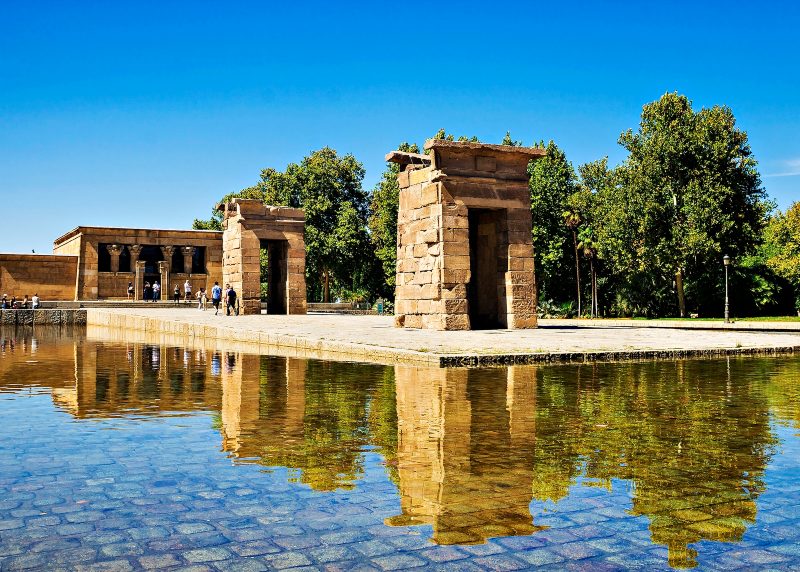
When reading about Madrid, The Temple of De Debod always interested me. An Egyptian temple in Madrid is something right out of left field. After doing a little reading, I discovered the temple was built in Aswan in the 2nd century BC. The temple was dedicated to the God Amun. The temple had a remarkable life. It was an important enough temple that alterations were made to it Pharaohs and Roman emperors Augustus and Tiberius. Anyway fast forward, the temple was to be flooded with the construction of the Aswan dam.
The Egyptian Government allowed the Spanish Government to move the temple. It was taken apart and resembled it brick by brick in The West Park, near the Royal Palace of Madrid. The temple is only open certain times of the year. It is a small but eye-catching temple surrounded by water and trees. The park’s location provides some great views of the Royal Palace and the city.
The Wyld Family took the hop on hop off bus and shared a review you might find helpful. They also have a great group for any of you travelling with teenagers.
Where: Calle de Ferraz, 1, 28008 Madrid
Visit Santiago Bernabéu Stadium
Mansoureh Farahani who writes at Travel with Manroureh and loves Madrid as much as we do. She thinks a visit to Real Madrid’s home ground is a must. We agree, we watched a game and it was an amazing experience.
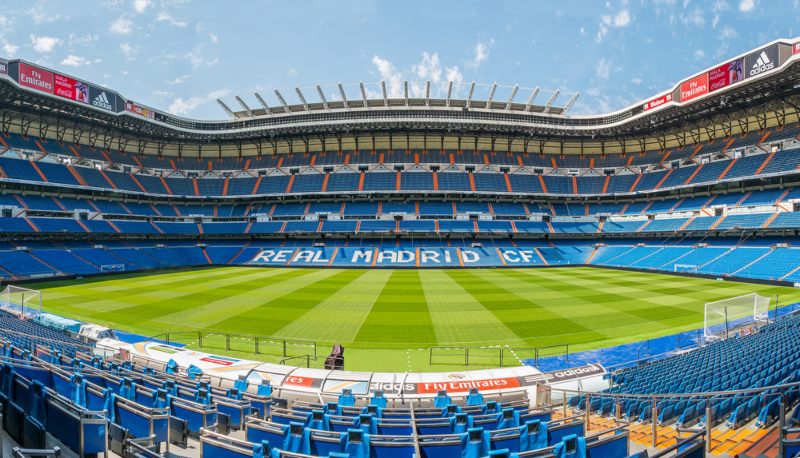
Madrid might be famous for its culture, history and arts, but we can’t ignore the fact that this Spanish city is home to one the most successful football clubs in the world, Real Madrid Football team. That is why Madrid could be a dream destination for football lovers and Real Madrid’s fans.
Visiting Santiago Bernabéu Stadium, Real Madrid’s stadium is a fun thing to do when you are in Madrid. It doesn’t matter if you are like me, not a big fan, but let be honest we all heard of the success of the team and its 100 years of history.
You can visit the stadium at any time between 09:30 to 19:00 (Monday to Saturday) and Sunday and bank holidays from 10:00 to 18:30, when there is no game.
You don’t have to book in advance, you can purchase the tickets at the gate and head to the entrance, but it can be a great idea in book in advance during peak season. It is better to go early in the morning to avoid queuing. The ticket for an adult would cost you 25,00 €, for children under 14 would be 18,00€. You can also get your entrance ticket with an audio guide for 31,00 €.
Your tour around the stadium starts as soon as you step in. You can follow the route at your own pace and visit different parts to get familiar with what goes on behind the scenes of each game.
You will visit the museum of the club, where there are all the medals and cups the team won. Then you can walk to the seats where you can have a panoramic view of the stadium. Then you can head to the VIP section and changing room and go through the tunnel onto the pitch.
Keep in your mind to visit all parts of the stadium would take you at least one hour.
Check out Mansoureh’s video on a weekend in Madrid
Related: How many of these Spanish UNESCO sites have you seen
Eat at Sobrino de Botín
We decided to celebrate my “big” birthday at the oldest restaurant in Madrid, the legendary Sobrino de Botín

If it was good enough for Hemmingway its good enough for my 50th right. Sobrino de Botin made my shortlist for this special occasion because of it its history but when I found out the signature dish was roast suckling pig we locked it in.
The restaurant opened in 1725 and has operated ever since, which Guinness Book of Records says makes it the oldest in the world. It famously appeared at the end of Hemmingway’s book The Sun Also Rises and apparently he ate here on several occasions.
We ordered the house special cochinillo asado and also the slow-roasted lamb, cordero asado. Both dishes are cooked in an oven that is over 300 years old.

Happy birthday to me! 
The second floor interior 
Roast lamb 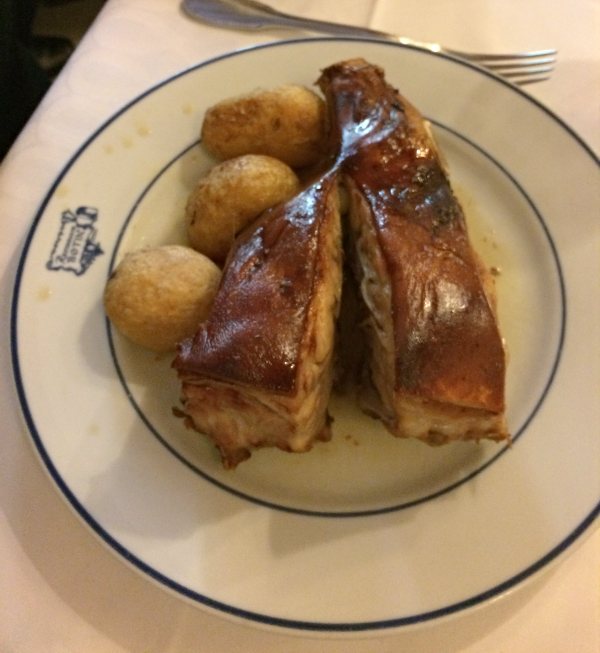
The house specilaity the sucking pig or cochinillo
Both dishes melted in the mouth, so tender and it is easy to see why they have stuck to the original recipes with very little change to the menu almost three centuries after opening.
Be sure to book and treat yourself to some of the most expensive croquettes you will find in Madrid while you are there. They are worth it.
Where: 17 Calle de Cuchilleros in Madrid
Drink vermouth at a classic vermuteria
Amber from Food And Drink Destinations travels the world in search of the best eats across the globe. I highly recommend you give this tip a try!

Spain is a food and drink paradise. In Madrid, there are loads of restaurants and bars to visit and experience the best of Spanish gastronomy. From tapas to incredible Spanish wines, Madrid has it all.
One gastronomic experience that most travellers overlook is drinking vermouth. When it comes to what to eat in Madrid, many people think of tapas, but there is more to food and drink in the city than tapas. An essential part of life in Spain, drinking vermouth at one of the many vermuterias (vermouth bars) found around Madrid is a must for any visitor.
So, what is vermouth? At its simplest, vermouth is a fortified wine, flavoured with herbs and spices. Vermouth can be white or red and is often a blend of bitter and sweet flavours. Served over ice and enjoyed before lunch or dinner, many locals will enjoy a glass of vermouth, alongside a tapa or pincho. It is believed that having vermouth prior to eating opens the appetite. You can find vermouth in just about every bar and restaurant in Madrid.
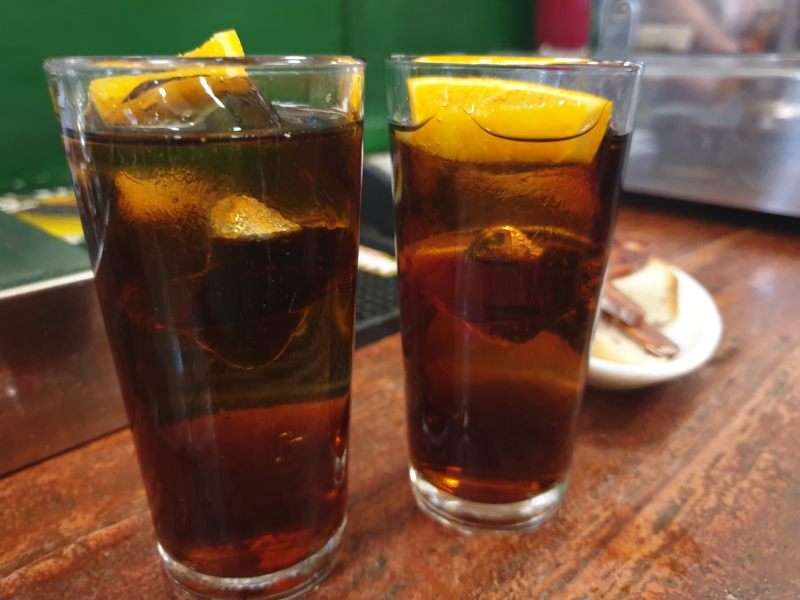
To truly experience this lesser-known beverage, it’s best to seek out a vermuteria. A vermuteria specializes in selling vermouth, along with beer and simple snacks like chorizo, Jamon and olives. One of the best vermuterias in Madrid is Bodegas Ricla. A five-minute walk from Plaza Mayor, Bodegas Ricla is a tiny old school vermuteria. While it is located on one of the main tourist streets (Calle de Cuchilleros), it is visited by locals and tourists alike.
Most visitors are attracted by the wide range and high-quality vermouth on offer. A glass of vermouth at Bodegas Ricla costs between €1.50 to €3.
Where: Bodegas Ricla Calle de Cuchilleros Madrid
Check out Amanda Madrid food guide for more great advice.
Related: Tips for visiting Barcelona for the first time
Join a Vegan Tapas Tour
Wendy Werneth is the talented creator behind The Nomadic Vegan and I am pleased to say that vegans won’t have to miss out on tapas tours in Madrid thanks to this great find.

Looking for something a bit different than the usual jamón-filled food tour? Try a vegan tapas tour of Madrid! Madrid Vegan Travel is a new company that offers vegan-friendly experiences in the city, including cooking classes and food tours. Even if you’re not vegan, it’s a great way to experience a different side of Madrid’s culinary scene.
Vegan restaurants have been popping up like mushrooms in Madrid over the past few years. The options run the gamut from vegan doughnuts and other junk food to healthy, whole-foods plant-based dishes. And many traditional local dishes have been veganized as well, including some foods you probably thought could never be made vegan … like calamari!
The vegan calamari I tasted on the vegan tapas tour completely blew me away. It was from an all-vegan food stall in a local market that most tourists don’t know about, and that I never would have come across on my own. The folks there really nailed the taste and texture with their calamari, which would fool any seafood lover.
The tour costs 68 euros and includes stops at four different local eateries. It’s perfect for vegans, vegetarians and people with allergies to animal products, but of course, anyone who is curious about what creative vegan chefs in Madrid are up to is welcome to join!
Follow the Nomadic Vegan on Instagram to stay up to date with Wendy’s finds.
Stroll around Retiro Park
Retiro Park was a short stroll from our apartment and quickly became our favourite spot for a morning walk. We were there in autumn when the colours were particularly spectacular and we managed to snap the shot below.
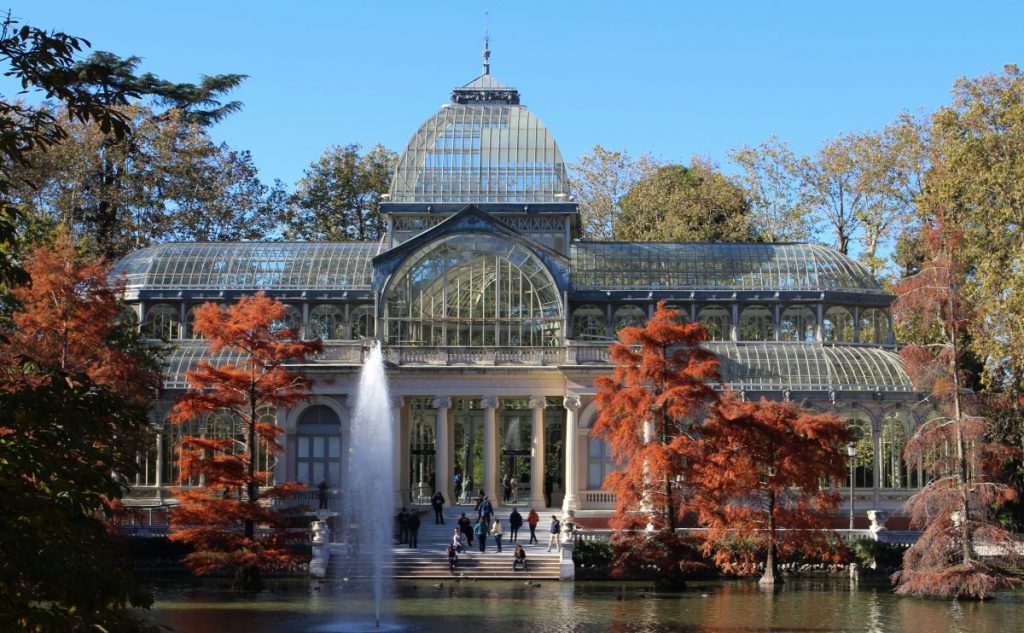
Parque del Buen Retiro was initially a private area used by royalty as a retreat for seasonal holidays. These days it is a local favourite and well used by everyone.
There are over 15000 trees here and several highlights including the Crystal Palace and the monument Alfonso XII monument where you can rent a rowboat and spent some time out on the manmade lake.
Be sure to check out the rose garden and the Paseo de las Estatuas, or the Statue Walk. If you have time book at a free guided tour.
Where: Plaza de la Independencia, 7, Madrid
So that’s a wrap
We didn’t list all the big-ticket things to do in the city as they will likely be in your guidebook. We wanted to help you choose a couple of local experiences to give your itinerary a good balance.
Just in case you are not sure of the most popular things to do Madrid we have included them below.
- Visit the Prado – one of the worlds best art galleries
- Take in a flamenco show
- Do the free walking tour to learn about the cities past
- Head to Puerta del Sol for some people watching
- Go shopping on Gran Vía
- Pick up some snacks at Mercado San Miguel
- Take a day tour to one of the nearby UNESCO sites like Segovia
There is so much to do in Madrid that your time will fly, so if you are an art lover, try to spend at least four days here. WIthout the museums, you could get by with three days.
Save these Best Madrid Experiences on Pinterest for your planning.

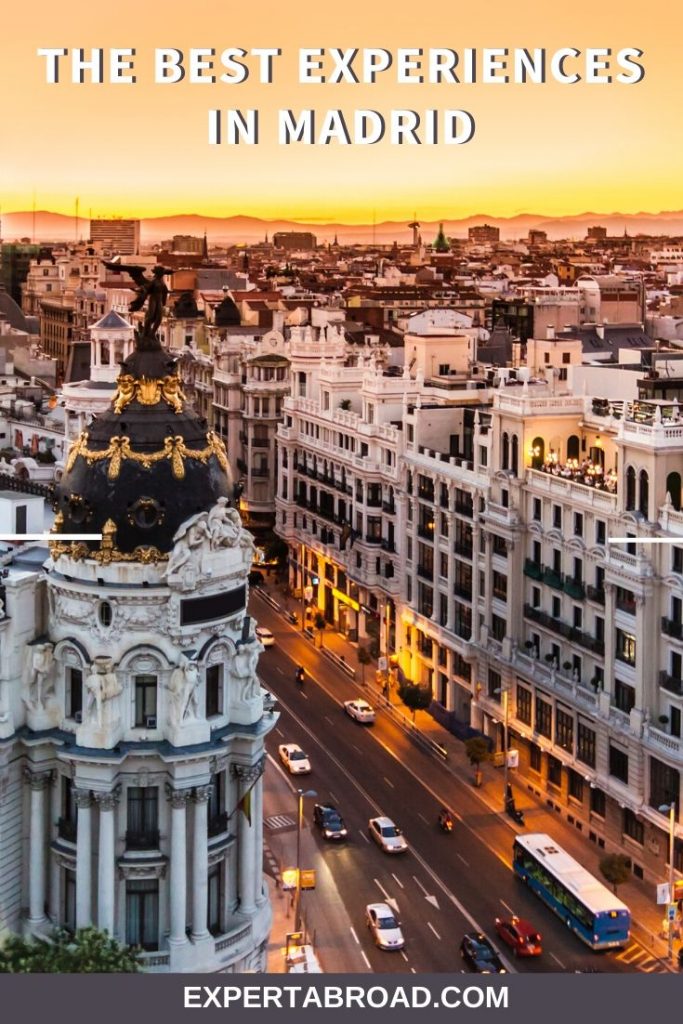
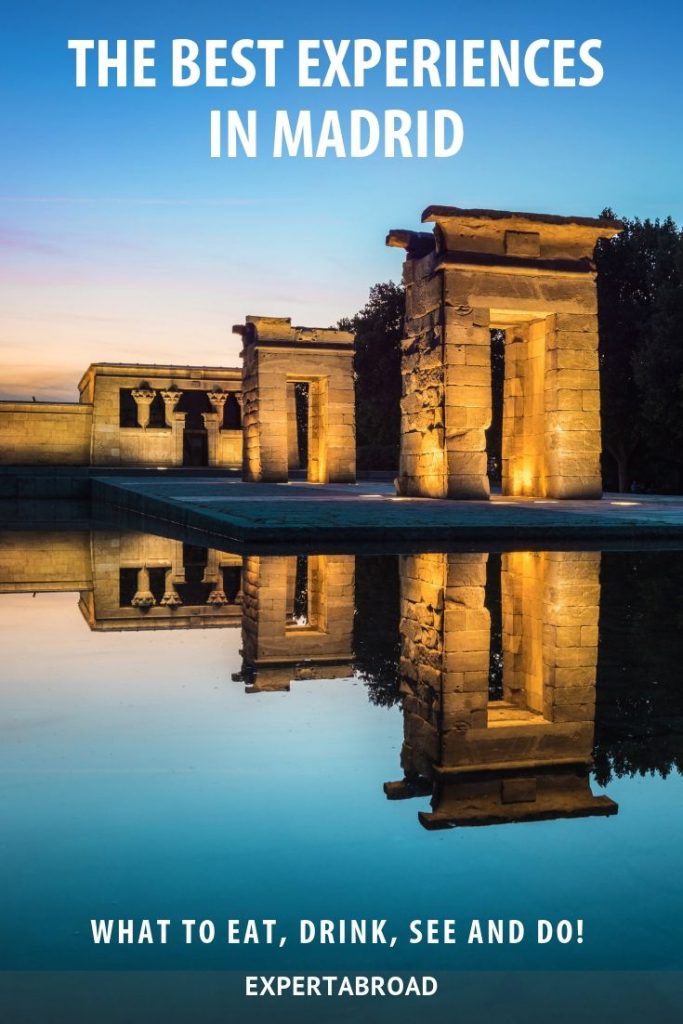
Have a question about something here? Want advice for planning your visit? Head to our Facebook page and we will do our best to help.



You have noted very interesting details ! ps nice website .
Really clean internet site, regards for this post.
I think this web site has got very fantastic written content material articles.
It’s onerous to find educated individuals on this matter, however you sound like you know what you’re talking about! Thanks
I just could not depart your site prior to suggesting that I extremely enjoyed the standard information a person provide to your visitors? Is gonna be back steadily in order to investigate cross-check new posts
Hello! I know this is kinda off topic nevertheless I’d figured I’d ask. Would you be interested in exchanging links or maybe guest authoring a blog article or vice-versa? My site goes over a lot of the same subjects as yours and I believe we could greatly benefit from each other. If you might be interested feel free to send me an e-mail. I look forward to hearing from you! Fantastic blog by the way!
I appreciate, cause I found exactly what I was looking for. You’ve ended my 4 day long hunt! God Bless you man. Have a great day. Bye
I would like to thnkx for the efforts you’ve put in writing this web site. I am hoping the same high-grade website post from you in the upcoming as well. In fact your creative writing skills has inspired me to get my own web site now. Actually the blogging is spreading its wings rapidly. Your write up is a great example of it.
Whats up very nice site!! Man .. Excellent .. Wonderful .. I’ll bookmark your website and take the feeds also…I’m glad to find so many useful info here in the post, we want work out extra strategies on this regard, thank you for sharing. . . . . .
Normally I do not learn article on blogs, however I wish to say that this write-up very pressured me to check out and do it! Your writing taste has been amazed me. Thank you, very great post.
I am impressed with this website , rattling I am a big fan .
Very instructive and good structure of articles, now that’s user genial (:.
After study a couple of of the blog posts on your web site now, and I really like your manner of blogging. I bookmarked it to my bookmark web site checklist and might be checking back soon. Pls try my web site as effectively and let me know what you think.
I have recently started a blog, the info you provide on this website has helped me tremendously. Thank you for all of your time & work.
Your article helped me a lot, is there any more related content? Thanks!
Hi, Neat post. There’s a problem with your website in internet explorer, may check thisK IE still is the market leader and a large component to folks will omit your excellent writing because of this problem.
Simply wanna remark that you have a very nice internet site, I like the design it really stands out.
I was recommended this website via my cousin. I’m no longer certain whether or not this post is written through him as nobody else know such special approximately my difficulty. You’re incredible! Thank you!
This is very interesting, You are a very skilled blogger. I have joined your rss feed and look forward to seeking more of your great post. Also, I have shared your site in my social networks!
Your place is valueble for me. Thanks!…
Im not positive where you’re getting your information, but good topic. I needs to spend a while studying much more or figuring out more. Thanks for wonderful info I was in search of this info for my mission.
This really answered my problem, thank you!
You are a very intelligent person!
Howdy very cool web site!! Man .. Beautiful .. Superb .. I’ll bookmark your web site and take the feeds additionally…I’m happy to find numerous helpful info right here within the submit, we’d like develop extra techniques in this regard, thanks for sharing. . . . . .
You are a very intelligent person!
Great blog right here! Also your site rather a lot up fast! What host are you using? Can I get your affiliate link for your host? I desire my web site loaded up as fast as yours lol
As a Newbie, I am permanently exploring online for articles that can aid me. Thank you
Its great as your other articles : D, appreciate it for posting.
Hi my family member! I wish to say that this post is awesome, nice written and include approximately all important infos. I’d like to look more posts like this .
Hello, Neat post. There’s an issue together with your website in internet explorer, might test thisK IE nonetheless is the marketplace chief and a large component of folks will pass over your fantastic writing due to this problem.
Hmm it appears like your blog ate my first comment (it was super long) so I guess I’ll just sum it up what I submitted and say, I’m thoroughly enjoying your blog. I too am an aspiring blog blogger but I’m still new to everything. Do you have any helpful hints for first-time blog writers? I’d definitely appreciate it.
What Is FitSpresso? FitSpresso is a dietary supplement that is made to support healthy fat-burning in the body
I know this if off topic but I’m looking into starting my own weblog and was wondering what all is required to get set up? I’m assuming having a blog like yours would cost a pretty penny? I’m not very web smart so I’m not 100 sure. Any recommendations or advice would be greatly appreciated. Kudos
Excellent web site. Plenty of useful info here. I am sending it to several pals ans also sharing in delicious. And naturally, thank you on your sweat!
Hey there just wanted to give you a brief heads up and let you know a few of the images aren’t loading properly. I’m not sure why but I think its a linking issue. I’ve tried it in two different web browsers and both show the same outcome.
Нужна помощь в выборе надежных мобильных прокси в Узбекистане
BYD Han обеспечивает плавное и комфортное движение в городских условиях и на
Врачи стоматологии в Ташкенте проводят лечение и профилактику заболеваний, связанных с кровеносной системой
terrible excellent effectiveness<br
Clearly presented. Discover more at
This was highly helpful. For more, visit
I’m impressed, I must say. Really not often do I encounter a blog that’s each educative and entertaining, and let me inform you, you’ve hit the nail on the head. Your idea is excellent; the issue is one thing that not enough people are speaking intelligently about. I am very comfortable that I stumbled across this in my seek for something referring to this.
Thanks for the detailed guidance. More at ##anyKeyword##
Dont get just about anything from below
Wonderful tips! Discover more at ##anyKeyword##
Thanks for the great explanation. More info at
This was highly educational. For more, visit ##anyKeyword##
I enjoyed this read. For more, visit
This was quite informative. For more, visit
Great job! Discover more at
I liked this article. For additional info, visit
lousy top quality products<br
Tại Tâm Beauty Clinic, chúng tôi xuất bản các nội dung đánh giá, bảng xếp hạng liên quan đến ngành làm đẹp, bao gồm các spa trị mụn, spa làm đẹp, spa dưỡng da,… Mỗi thương hiệu được đưa vào bảng xếp hạng đều trải qua quá trình sàng lọc kỹ lưỡng
This was highly educational. More at
Well done! Discover more at
Thanks for the practical tips. More at ##anyKeyword##
Appreciate the insightful article. Find more at
Appreciate the thorough write-up. Find more at ##anyKeyword##
Wonderful website. A lot of helpful info here. I?¦m sending it to some friends ans also sharing in delicious. And certainly, thanks for your sweat!
¿Qué opinas del mejor concurso SEO: ##anyKeyword##? ¿Estás particip
Thanks for the informative content. More at ##anyKeyword##
Avage AI: Transforme Sua Estratégia de Trading no Brasil
Avage AI é uma aplicação de trading avançada, projetada especialmente para o mercado brasileiro
I view something genuinely special in this internet site.
Great job! Discover more at ##anyKeyword##
Человек-паук: Через вселенные (2018): Удивительный анимационный фильм, полный героизма и приключений
Thanks for sharing excellent informations. Your web-site is so cool. I’m impressed by the details that you have on this site. It reveals how nicely you perceive this subject. Bookmarked this website page, will come back for extra articles. You, my pal, ROCK! I found just the info I already searched all over the place and just couldn’t come across. What a perfect web site.
Thanks for the helpful article. More like this at ##anyKeyword##
Valuable information! Find more at ##anyKeyword##
What Is ErecPrime? ErecPrime is a male enhancement supplement that will help with improving one’s sexual experience.
Great
I think everything posted was actually very logical. However, think on this, what if
you added a little information? I ain’t saying your content is not good., however what if you added a headline that grabbed a person’s attention?
I mean The Best Madrid Experiences for your first visit | Expert Abroad is a little
vanilla. You ought to peek at Yahoo’s home page and
note how they write post headlines to grab people interested.
You might try adding a video or a related picture or two to grab people interested about everything’ve got to say.
In my opinion, it would bring your posts a little livelier.
I know this web site provides quality dependent articles or
reviews and other information, is there any other web page which offers these
kinds of data in quality?
I’m curious to find out what blog system you
have been using? I’m experiencing some small security problems with my latest website and I would like to find something more safe.
Do you have any recommendations?
I just like the helpful info you supply to
your articles. I will bookmark your blog and check again right here regularly.
I am rather certain I will be informed many new
stuff right here! Best of luck for the following!
I love it when people come together and share opinions, great blog, keep it up.
Pretty section of content. I just stumbled upon your weblog and in accession capital to assert that I get in fact
enjoyed account your blog posts. Anyway I’ll be subscribing to your augment and even I achievement
you access consistently rapidly.
Great post, you have pointed out some good details , I as well believe this s a very wonderful website.
I’m very pleased to uncover this site. I wanted to thank
you for ones time just for this wonderful read!!
I definitely loved every bit of it and i also have
you saved as a favorite to see new things on your site.
If some one wants expert view concerning blogging and site-building then i advise him/her to go to see this weblog, Keep up the pleasant work.
Everyone loves it when individuals come together and share ideas.
Great blog, stick with it!
First off I would like to say wonderful blog! I had a quick question in which I’d like to ask if you don’t mind.
I was curious to know how you center yourself and clear your thoughts prior to
writing. I’ve had difficulty clearing my thoughts in getting my
ideas out there. I truly do enjoy writing however it just seems like the first 10 to 15 minutes tend
to be lost simply just trying to figure out how to
begin. Any recommendations or tips? Kudos!
Thank you for every other informative blog.
The place else could I get that type of information written in such an ideal method?
I’ve a venture that I am simply now operating on, and I have been on the glance out for such info.
It’s really very complex in this full of activity life
to listen news on TV, so I only use the web for that reason, and take the most recent information.
Hey there! I’m at work browsing your blog from my new iphone!
Just wanted to say I love reading your blog and look forward to all your posts!
Keep up the outstanding work!
Someone essentially help to make seriously articles I would state.
This is the very first time I frequented your web page and up to now?
I amazed with the analysis you made to create this
actual put up incredible. Magnificent process!
Glad to be one of several visitors on this awful web site : D.
What’s up to every one, the contents present at this website are truly awesome
for people knowledge, well, keep up the nice work fellows.
I got this website from my pal who shared with me on the topic of this
web site and at the moment this time I am browsing this website and reading very informative articles at this place.
whoah this blog is wonderful i really like studying your articles.
Keep up the good work! You understand, many persons are
hunting round for this information, you could help
them greatly.
Write more, thats all I have to say. Literally, it
seems as though you relied on the video to make your point.
You definitely know what youre talking about, why waste your
intelligence on just posting videos to your blog when you could be
giving us something informative to read?
Regards for this post, I am a big big fan of this site would like to go along updated.
I blog frequently and I truly thank you
for your information. The article has really peaked my interest.
I’m going to take a note of your blog and keep checking for new information about once a week.
I subscribed to your Feed as well.
I got this website from my friend who told me about this website and at the moment this time I am visiting this site and
reading very informative articles or reviews at this place.
I all the time emailed this blog post page to all my friends,
because if like to read it next my contacts will too.
Good article. I definitely love this website.
Keep writing!
Simply want to say your article is as astounding. The clarity in your publish is simply excellent and that i could think you are a professional in this subject. Fine with your permission let me to clutch your RSS feed to stay updated with coming near near post. Thank you 1,000,000 and please continue the rewarding work.
I really like it when people come together and share thoughts.
Great site, keep it up!
hello!,I really like your writing very much! percentage we keep in touch extra about
your post on AOL? I need a specialist in this space to solve my problem.
Maybe that is you! Having a look forward to peer you.
hey there and thank you for your info – I’ve certainly
picked up something new from right here. I did however expertise several technical points using this site,
since I experienced to reload the web site many times
previous to I could get it to load properly. I had been wondering if your hosting is
OK? Not that I am complaining, but sluggish loading instances times will sometimes affect your placement in google and can damage your quality score if ads
and marketing with Adwords. Anyway I’m adding this RSS to my email and could look out for a lot more
of your respective intriguing content. Make sure you update this again very
soon.
Hello there! This post couldn’t be written any better!
Reading this post reminds me of my good old room mate! He always kept talking about this.
I will forward this write-up to him. Pretty sure he will have a
good read. Many thanks for sharing!
I’m gone to tell my little brother, that he should also pay a visit this webpage
on regular basis to take updated from most up-to-date information.
Hi, I think your blog might be having browser compatibility issues.
When I look at your website in Ie, it looks fine but when opening in Internet
Explorer, it has some overlapping. I just wanted to
give you a quick heads up! Other then that, amazing blog!
My spouse and I stumbled over here by a different page and thought I
may as well check things out. I like what I see so now i’m following you.
Look forward to exploring your web page repeatedly.
Мы все признаем важность игр в казино, но мы редко видим, как они развиваются со временем.
No matter if some one searches for his required thing, therefore he/she
wants to be available that in detail, therefore that thing is maintained over here.
It’s really a nice and useful piece of information. I’m satisfied that you simply shared this useful information with us.
Please keep us up to date like this. Thanks for sharing.
I read this paragraph fully concerning the comparison of most up-to-date and
earlier technologies, it’s amazing article.
Yes! Finally someone writes about Hokicoy.
I do agree with all the ideas you’ve presented to your post.
They’re really convincing and will definitely
work. Still, the posts are very short for newbies. May just you please lengthen them a bit from subsequent time?
Thank you for the post.
Everything is very open with a really clear clarification of the challenges.
It was truly informative. Your site is useful. Many thanks for
sharing!
Hi there to every body, it’s my first pay a quick visit
of this webpage; this website includes remarkable and in fact
excellent information in favor of visitors.
Hello! I could have sworn I’ve been to this site before but after checking through some of the post I realized it’s new to me.
Anyhow, I’m definitely delighted I found it and I’ll be bookmarking and checking back frequently!
Fantastic beat ! I wish to apprentice while you amend your
website, how could i subscribe for a blog web site?
The account helped me a acceptable deal. I had been tiny bit acquainted of this
your broadcast offered bright clear idea
Attractive section of content. I just stumbled upon your
web site and in accession capital to claim that I get in fact enjoyed account your
weblog posts. Any way I will be subscribing for your feeds and even I success you get admission to consistently quickly.
I am regular reader, how are you everybody? This post posted at this
site is really nice.
Good information. Lucky me I came across your blog by accident (stumbleupon).
I have bookmarked it for later!
Wonderful article! We are linking to this particularly great
article on our website. Keep up the great writing.
Hello colleagues, pleasant post and nice arguments commented at this place, I
am genuinely enjoying by these.
Spodziewaj się najlepszych automatów, Zapisz i zwróć-saldo zostanie automatycznie zapisane podczas przerwy.
Excellent pieces. Keep writing such kind of info on your
site. Im really impressed by it.
Hey there, You’ve performed an excellent job.
I will certainly digg it and in my opinion recommend
to my friends. I’m confident they will be benefited from this website.
Do you have a spam issue on this blog; I also am a blogger, and I
was wanting to know your situation; we have developed some nice procedures and we are looking to swap methods with other folks, why not
shoot me an e-mail if interested.
My partner and I stumbled over here by a different web address and thought I should check things out.
I like what I see so i am just following you.
Look forward to finding out about your web page repeatedly.
It is not my first time to go to see this site, i am visiting
this web page dailly and get pleasant information from here every day.
Thanks for every other excellent post. Where else could anybody get
that kind of information in such an ideal way of
writing? I’ve a presentation subsequent week, and I’m on the look for such information.
Usually I do not learn post on blogs, but I wish to
say that this write-up very compelled me
to try and do it! Your writing style has been surprised me.
Thank you, very great article.
Spot on with this write-up, I truly think this site needs far more attention. I’ll probably be returning to read
more, thanks for the advice!
Excellent beat ! I wish to apprentice even as you amend your site, how could i
subscribe for a blog site? The account aided me a appropriate deal.
I were tiny bit acquainted of this your broadcast provided vivid transparent concept
Have you ever considered about adding a little bit more
than just your articles? I mean, what you say is fundamental and everything.
But think of if you added some great graphics or video clips to give your posts more, “pop”!
Your content is excellent but with images and clips, this blog could definitely be one
of the most beneficial in its field. Terrific blog!
What’s up to every one, it’s actually a pleasant for me to
go to see this website, it contains useful Information.
Hello! I could have sworn I’ve visited this website before but after
going through a few of the articles I realized it’s new to me.
Anyways, I’m certainly delighted I discovered it and I’ll be bookmarking it and checking back often!
Nice post. I learn something totally new and challenging on sites I stumbleupon every day.
It will always be interesting to read through articles from other authors and practice something from their web sites.
Hi there just wanted to give you a quick heads up.
The words in your content seem to be running off the screen in Firefox.
I’m not sure if this is a format issue or something to do with internet browser compatibility but I thought I’d post to let you know.
The layout look great though! Hope you get the problem solved soon. Many thanks
I’m no longer certain where you’re getting your info, but great
topic. I needs to spend some time studying much more or working out more.
Thanks for fantastic information I was on the lookout for this info
for my mission.
Hi to every body, it’s my first visit of this blog; this blog
consists of remarkable and truly fine stuff designed for readers.
Highly energetic blog, I loved that a lot. Will there be a part 2?
I have read so many articles or reviews regarding the blogger lovers except this
piece of writing is genuinely a pleasant paragraph, keep it up.
Hey! This is kind of off topic but I need some guidance from an established blog.
Is it difficult to set up your own blog? I’m not very techincal but I can figure things out pretty
quick. I’m thinking about creating my own but I’m not sure
where to begin. Do you have any tips or suggestions? With
thanks
wonderful put up, very informative. I wonder why the opposite specialists of this sector don’t realize this.
You must continue your writing. I’m confident, you have a great readers’ base already!
If you want to increase your familiarity only keep visiting this site and be
updated with the most up-to-date gossip posted here.
My partner and I stumbled over here different page and thought
I should check things out. I like what I see so now i’m
following you. Look forward to looking over your web page for a
second time.
Hello, I desire to subscribe for this weblog to take latest updates,
thus where can i do it please assist.
Magnificent site. Plenty of useful info here. I’m sending it to several pals ans additionally sharing in delicious.
And naturally, thank you on your sweat!
It’s in fact very complicated in this busy life to listen news on TV,
so I simply use internet for that purpose, and get the most recent information.
My spouse and I stumbled over here by a different web address and thought I should check things out.
I like what I see so now i am following you. Look forward to going over your web page repeatedly.
Thanks for any other wonderful article. Where else may anyone get that kind of info in such a
perfect method of writing? I have a presentation next week, and I’m at the look for such information.
Nice post. I learn something totally new and challenging on websites I stumbleupon on a
daily basis. It’s always useful to read through articles from other writers and practice something from their web sites.
My partner and I stumbled over here coming from a different website
and thought I might check things out. I like
what I see so now i am following you. Look forward to going over your web page repeatedly.
Just desire to say your article is as amazing. The clarity to your submit
is just spectacular and i can assume you’re knowledgeable in this subject.
Fine with your permission let me to take hold of your RSS feed
to stay updated with imminent post. Thanks one million and please continue the rewarding work.
Exceptional post however I was wanting to know if you could write a litte
more on this topic? I’d be very grateful if you could elaborate a little bit more.
Appreciate it!
These are really impressive ideas in concerning blogging.
You have touched some nice things here. Any way keep up wrinting.
My partner and I absolutely love your blog and find many of your post’s to be precisely what I’m looking for.
Do you offer guest writers to write content for you
personally? I wouldn’t mind composing a post or elaborating on most of the subjects
you write related to here. Again, awesome web log!
Pretty! This was an incredibly wonderful article. Thanks for providing
this info.
Hello there! This article could not be written any better!
Reading through this post reminds me of my previous roommate!
He constantly kept preaching about this. I most certainly will forward this article to him.
Pretty sure he’s going to have a great read. Thanks for sharing!
This paragraph will assist the internet users for building up new webpage or even a blog
from start to end.
Fine way of describing, and good paragraph to get information regarding my presentation topic, which i am going to deliver in academy.
I’m not sure exactly why but this web site is loading extremely slow for me.
Is anyone else having this issue or is it a problem on my
end? I’ll check back later and see if the problem still exists.
Hello terrific website! Does running a blog similar to this take a large amount of work?
I have very little understanding of computer
programming however I had been hoping to start my own blog in the near future.
Anyways, should you have any ideas or tips for new blog owners please share.
I understand this is off topic but I simply wanted to ask.
Cheers!
With havin so much content and articles do you ever run into any issues
of plagorism or copyright violation? My blog has a lot of completely unique content I’ve either authored
myself or outsourced but it seems a lot of it is popping it up all over
the internet without my authorization. Do you know any methods to help protect against content from being stolen? I’d genuinely
appreciate it.
What’s up mates, its enormous article on the topic of teachingand
entirely explained, keep it up all the time.
Does your blog have a contact page? I’m having problems locating it but, I’d like to send you an email.
I’ve got some ideas for your blog you might be interested in hearing.
Either way, great blog and I look forward to seeing it
grow over time.
Hello! I’m at work surfing around your blog from my new apple iphone!
Just wanted to say I love reading through your blog and look forward to all your posts!
Carry on the superb work!
Its like you read my mind! You appear to know so much
about this, like you wrote the book in it or something. I think that
you can do with some pics to drive the message home a little bit, but instead
of that, this is great blog. A great read. I’ll certainly be
back.
Greate pieces. Keep writing such kind of information on your page.
Im really impressed by it.
Hello there, You’ve performed a fantastic job. I’ll certainly digg it and
in my opinion suggest to my friends. I’m confident they’ll be benefited
from this site.
Can you be more specific about the content of your article? After reading it, I still have some doubts. Hope you can help me.
Thank you for your sharing. I am worried that I lack creative ideas. It is your article that makes me full of hope. Thank you. But, I have a question, can you help me?
I don’t think the title of your article matches the content lol. Just kidding, mainly because I had some doubts after reading the article.
That evening shot is beautiful. The Edith Grossman translation of Don Quixote is brilliant and very Monty Pythonesque, if you haven’t read it.
Wow…so many places we didn’t get to see back in April this year when we were there. Next time